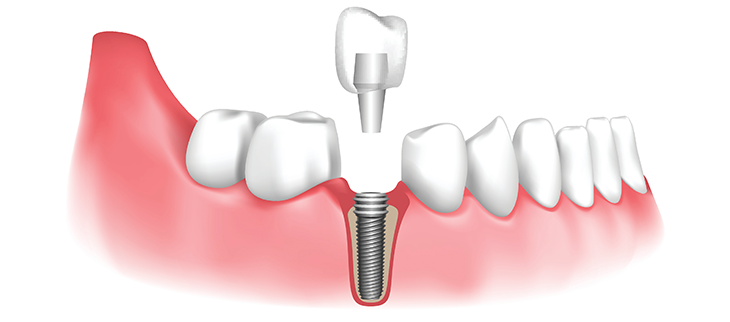10 Easy Facts About Dental Sense Shown
Table of ContentsLittle Known Questions About Dental Sense.The 25-Second Trick For Dental Sense7 Simple Techniques For Dental SenseThe Best Guide To Dental Sense
are clinical devices surgically dental implanted right into the jaw to bring back an individual's capability to eat or their appearance. They provide assistance for artificial (fake) teeth, such as crowns, bridges, or dentures. When a tooth is shed as a result of injury or illness, a person can experience difficulties such as rapid bone loss, malfunctioning speech, or adjustments to eating patterns that lead to discomfort.Dental implant systems contain a dental implant body and oral implant abutment and may also include an abutment fixation screw. Dental implants. The dental implant body is surgically inserted in the jawbone instead of the tooth's root. The oral implant abutment is normally connected to the implant body by the joint fixation screw and expands via periodontals into the mouth to sustain the affixed synthetic teeth
(https://www.intensedebate.com/people/dentalsense1)Structure of The Dental Implant System picking oral implants, speak to your dental provider concerning the possible benefits and risks, and whether you are a prospect for the procedure. Things to consider: Your general health and wellness is an essential factor in determining whether you are a good prospect for dental implants, how much time it will certainly require to recover, and how much time the dental implant might stay in area.
Smoking cigarettes may impact the healing procedure and lower the long-lasting success of the dental implant. The healing procedure for the dental implant body may take several months or longer, throughout which time you commonly have a momentary abutment instead of the tooth. the dental implant treatment: Very carefully follow the dental hygiene directions offered to you by your oral supplier.
Some Ideas on Dental Sense You Should Know
Implant failure can lead to the demand for one more procedure to repair or replace the dental implant system. Brings back the capability to eat Brings back cosmetic appearance Assists maintain the jawbone from reducing due to bone loss Preserves the health and wellness of the surrounding bone and gum tissues Aids keep surrounding (nearby) teeth stable Boosts lifestyle Damages to bordering all-natural teeth throughout implant positioning Injury to the surrounding cells throughout surgical treatment, such as sinus opening Injury throughout surgical procedure (for example, crack of surrounding jawbone) Insufficient function, such as feeling like the teeth do not attack together generally A sensation that the tooth hangs or twisting in location resulting from an abutment screw loosening Implant body failure (looseness of the dental implant body) due to systemic infection, which may be more probable in clients with unrestrained diabetes mellitus as a result of local infection in bone and periodontals sustaining the implant body because of postponed healing, which may be much more most likely in patients that smoke Difficulty cleaning the gums around the dental implant, resulting in poor oral hygiene Without treatment periodontal condition Post-surgical numbness as a result of nerve impingement or damages Always notify health care service providers and imaging specialists that you have dental implants before any kind of magnetic vibration imaging (MRI) or x-ray procedures.
FDA is not familiar with any type of negative events reported for MRI or x-ray procedures with dental implants. Dental implants systems are usually made from products that follow international agreement standards of the International Company for Standardization (ISO) or ASTM International. These criteria have information of what makes a safe product.

An oral implant is a framework that changes a missing out on tooth. With screw-like tools, the surgeon inserts a dental implant right into the jawbone, and it acts as a support for a synthetic tooth, called a crown.
How Dental Sense can Save You Time, Stress, and Money.
Some people are not qualified for dental implant surgical procedure. It is for oral specialists to run on people with: severe illnessuncontrollable metabolic diseasebone or soft cells illness or infectionIf these problems are resolved, an individual can have the surgical treatment. In, oral cosmetic surgeons avoid from operating people with: If people with any of the above undergo oral implant surgical procedure, there is a greater danger of the implant failing.

Dental dental implant surgical treatment is a customized procedure. Offer you time to recover. Connect the message and last crown, bridge or denture.
Next, your surgeon will carefully put the dental implant right into your jaw. Finally, your doctor will certainly rearrange your gums and close the incision with stitches. If your dental implant is near the front of your mouth, your dentist will certainly make a temporary tooth for you to put on until you recover. In this way, you won't have a void in your smile while you recover.
Some Of Dental Sense
Your service provider can inform you what to expect in your scenario. During the healing phase, your jawbone should fuse to the oral implant. This process, called osseointegration, is essential for stability and lasting success. This procedure can take anywhere from three to nine months. Sometimes, it might take much longer.
As soon as your implant heals, your dentist can connect the joint (tiny connector article) and your last restoration (crown, bridge or denture). This normally takes concerning one hour to complete and may need a 2nd small surgery. You shouldn't feel any type of discomfort during your dental implant procedure anchor due to the fact that your supplier will certainly use medication to numb your gum tissues.